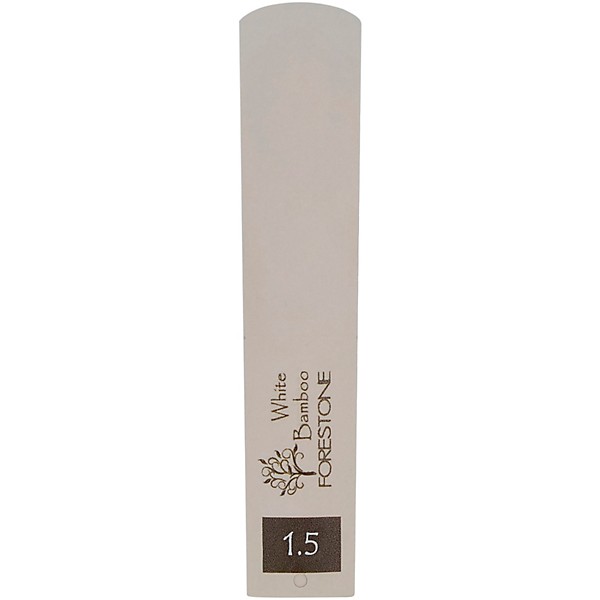Gear SpecialistBundlingMusician
Forestone White Bamboo Tenor Saxophone Reed 1.5
Q&A|Item #:1500000326511 POS #:116488305
This item is backordered but is available to reserve now. You will not be charged until the item ships.
Notify me when this item is in stock.
6-month special financing^ + $2 back in Rewards** Limited time Learn More
Style:1.5
Save on orders $199+ and get expert advice from a Gear Adviser
Need Help?

Description
For a durable option for your sax, look to the Forestone White Bamboo tenor saxophone reed. The Forestone material is a mixture of polypropylene resin and cellulose wood fiber. Over 50 percent of the wood fiber used is bamboo. The material is tasteless, odorless and non-toxic. This material results in the exceptional sound, resilience and flexibility of Forestone reeds.
Fabrication
Forestone reeds are made by proprietary injection molding developed in Japan. This results in reeds with smooth vamps that are uniform and consistent from reed to reed.
Construction and Profile
Forestone reeds are perfectly balanced side to side and front to back. The standard profile tapers down to 0.1 mm thickness across the tip. Held to the light, the reeds display the classic upside-down “U-shape” associated with cane.
Performance
Forestone reeds tend to maintain their strength and resistance over time. They vibrate well and hold the center of the sound in a manner similar to that of a good quality cane reed. The basic timber is robust, clear and strong, with enough “buzz” to ensure projection and carrying power. Intonation is stable and the reeds articulate well throughout the range of the saxophone.
Feel
The difference in feel between Forestone and cane is minimal. Player should take some time to get comfortable with Forestone, in the same way as he or she would to get comfortable with a new mouthpiece, ligature, barrel or instrument.
Adjustment
Blowing resistance can be adjusted with Forestone reeds by slightly raising or lowering the reed on the mouthpiece table (lower placement = less resistance, higher placement = more resistance). Although other types of adjustment are usually not needed, the material is sufficiently tough that one can still do so using blades, files, sandpaper, reed rush or other tool. Forestone reeds may also be clipped.
Longevity
The life of a Forestone reed will vary from player to player given that everyone’s embouchure address stresses the reed differently. Forestone reeds will outlast cane as the proprietary composite material is impervious to water-logging and breakdown by saliva, and will not warp due to changes in humidity or altitude. After a certain number of hours, however, the reeds will begin to feel less lively and responsive. The loss in vitality signals the time has come to retire the reed in favor of a newer one.
Fabrication
Forestone reeds are made by proprietary injection molding developed in Japan. This results in reeds with smooth vamps that are uniform and consistent from reed to reed.
Construction and Profile
Forestone reeds are perfectly balanced side to side and front to back. The standard profile tapers down to 0.1 mm thickness across the tip. Held to the light, the reeds display the classic upside-down “U-shape” associated with cane.
Performance
Forestone reeds tend to maintain their strength and resistance over time. They vibrate well and hold the center of the sound in a manner similar to that of a good quality cane reed. The basic timber is robust, clear and strong, with enough “buzz” to ensure projection and carrying power. Intonation is stable and the reeds articulate well throughout the range of the saxophone.
Feel
The difference in feel between Forestone and cane is minimal. Player should take some time to get comfortable with Forestone, in the same way as he or she would to get comfortable with a new mouthpiece, ligature, barrel or instrument.
Adjustment
Blowing resistance can be adjusted with Forestone reeds by slightly raising or lowering the reed on the mouthpiece table (lower placement = less resistance, higher placement = more resistance). Although other types of adjustment are usually not needed, the material is sufficiently tough that one can still do so using blades, files, sandpaper, reed rush or other tool. Forestone reeds may also be clipped.
Longevity
The life of a Forestone reed will vary from player to player given that everyone’s embouchure address stresses the reed differently. Forestone reeds will outlast cane as the proprietary composite material is impervious to water-logging and breakdown by saliva, and will not warp due to changes in humidity or altitude. After a certain number of hours, however, the reeds will begin to feel less lively and responsive. The loss in vitality signals the time has come to retire the reed in favor of a newer one.
Features
- Features a French filed cut with a lively response and a free sound
- Made for universal use in all styles
- Available Strength: 2.0, 2.5, 3.0, 3.5
- Instrument: Tenor saxophone






